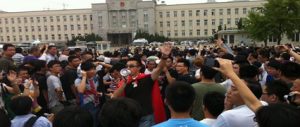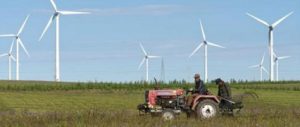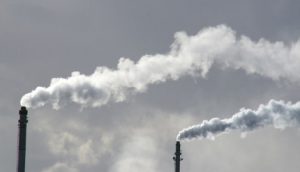An end to the obsession with GDP growth?
In the words of Chinese environmental campaigner Ma Jun, “More and more Chinese people are coming to understand that development founded on ever greater resource consumption is not sustainable.” But this mode of development is what has maintained GDP growth, jobs and political careers. Will China’s new leaders be able to shift the approach? In an interview with chinadialogue this week, Tsinghua University professor Daniel Bell says the promotion system for local officials will need to change, so they are rewarded for environmental protection as well as economic growth.
Transparency
A furore over Beijing’s air quality and the gap between official reporting and reality was one of the biggest stories in China last year, and points to the sorts of data issues the new regime will have to grapple with as social media grows ever more influential.
Widespread calls for local governments to release information on pollutant PM2.5 achieved just that: in March, the government revised national air quality regulations, tightening standards and reporting rules. But the new regime still has work to do to build trust in its air pollution data. Steven Q Andrews, the environmental consultant who first broke the Beijing air manipulation story back in 2008, in the run-up to the Olympic Games,
still has concerns about the veracity of the reporting. Government warnings against foreign embassies releasing their own data have worried commentators like
Zhou Rong of Greenpeace that officials have missed the point.
Civil unrest
Environmental protests are growing in China, as is the use of social media as a tool for organisation and protest. This year alone, demonstrations against a planned copper refinery, waste-water pipeline and PX plant in Shifang, Qidong and Ningbo, among others, driven by concerns about pollution, have made international headlines. The challenge of civil protest will remain for the new administration. For columnist Tang Hao, the heart of the problem is a “
crisis of local rule”, and the growth of environmental protests a “final warning” that reform of local governance is essential: “Hard decisions must be taken to reform the political system, to face up to people’s desire for political participation…to rein in local government’s untrammelled economic development.”
Beefing up the legal system
While there has been plenty of praise for China’s efforts to create a comprehensive set of environmental laws, disappointment in how these have been implemented has been palpable on
chinadialogue in recent years. Xia Jun’s “
China’s courts fail the environment” and Wang Jin’s “
China’s green laws are useless” show the gulf that lawyers and academics see between the paper policies and reality on the ground. Can Xi Jinping’s administration make China’s legal system a more powerful weapon against pollution?
Preparing for natural disasters
On July 21, at least 37 people were killed in Beijing in the heaviest rains the Chinese capital has seen since records began more than 60 years ago. Many other parts of the country also grappled with the impacts of torrential summer rains. The new leadership will no doubt be aware of the challenge.
Flood official Cheng Xiaotao told
chinadialogue too much of the focus has been on responding to disasters rather than preventing them. Meanwhile, in the wake of a spat about just how vulnerable Shanghai is to disaster,
Cleo Paskal pointed to the economic and political risks of the city being hit by a Katrina-style disaster.
What about the 12th Five-Year Plan?
China’s new leaders are coming into power half way through the period of the 12
th Five-Year Plan. While the development programme has been widely praised as the country’s greenest blueprint to date, how it is actually being implemented is less clear. Realising ambitious renewable and nuclear energy deployment targets, increasing forest cover and cutting release of major pollutants by 8-10% are among the challenges. It’s worth remembering that a
last minute dash to meet the environmental requirements of the 11
th Five-Year Plan led certain provinces to roll out power cuts, including to hospitals. For a detailed analysis of the 12
th FYP challenge, see our report “
China’s Green Revolution: Energy, Environment and the 12th Five-Year Plan”.
Global climate negotiations
China’s role in global efforts to tackle climate change will remain in the spotlight, and are set to be on show later this month at the next round of UN-led climate negotiations in Qatar. Writing on
chinadialogue during the Rio+20 summit in June,
Zheng Yisheng urged China to take a cooperative stance towards international efforts to tackle common environmental problems. China will also soon
have to decide whether or not to continue blocking proposals to phase out “super greenhouse gases” HFCs.
Escalating trade tensions
Yesterday, the US International Trade Commission
decided to uphold higher tariffs on imports of solar cells from China, imposed to offset subsidies paid to manufacturers by the Chinese government. It’s the latest signal of escalating trade tensions between the two countries as each tries to protect its own clean tech industry.
Energy expert Zhang Haibin told
chinadialogue that a “conflicting message” from the United States – encouraging renewables in China while seeing them as a threat – was a setback for international climate talks. Meanwhile,
Li Junfeng has argued that blind expansion of Chinese solar firms is the main obstacle to progress in the industry, and that bankruptcies are likely.





